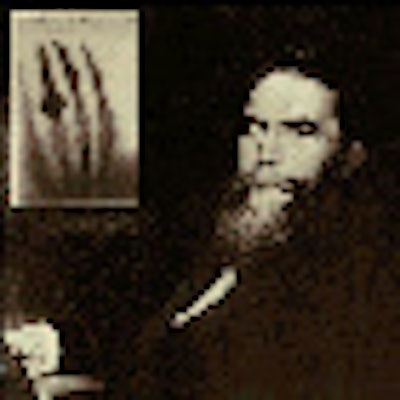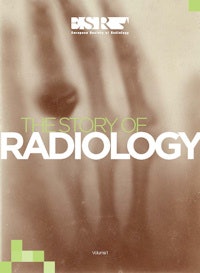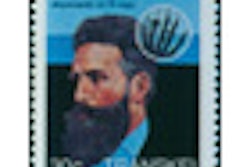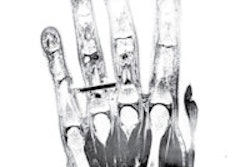
A new publication from the European Society of Radiology (ESR), which is supported by two other major sponsors and contains essays by five contributors, represents a precise and abundant source of reliable history and documentation. It has value to scholars of ancient and current radiology, as well as being of general interest to anybody working in medical imaging.
It is a common historic understanding that Wilhelm Conrad Röntgen, a German physicist, discovered x-rays on 8 November 1895 and published the first of his three articles in early January 1896. Then he abandoned x-ray research and moved on to other physics.
 ESR is offering a free booklet that covers some radiology history.
ESR is offering a free booklet that covers some radiology history.
What is essential for the early acceptance of x-ray technology is the efforts of thousands of physicians and scientists who accepted the application of x-rays for the diagnosis and treatment of human patients. In 1896, more than 1,000 scientific articles were published in Europe and North America, and the scientific effort to reach modern radiology in a second century has stimulated the growth of major radiologic organizations.
After the first European day of radiology on 10 February 2011, the ESR established the International Day of Radiology (IDoR) on 8 November 2012, with the cooperation of the Radiological Society of North America (RSNA) and the American College of Radiology (ACR). To coincide with the event, the ESR published an important book containing five historic articles, each drafted by a leading member of the International Society for the History of Radiology (ISHRAD). Besides its publication by the ESR, the book can be downloaded free of charge from the IDoR website.
The contributors include Drs. Uwe Busch from Germany, Alfredo Buzzi from Argentina, as well as Arpan K. Banerjee, Elizabeth Beckmann, and Adrian Thomas, all from the U.K.
The article by Buzzi recounts the growth of medicine before Röntgen's x-ray discovery and its widespread acceptance. He cites the pre-Christian accumulations by Egypt, China, Babylon, and, most significantly, in Greece the scholar Hippocrates. He acknowledges their perception of blood, phlegm, bile, and black bile. Then he traces the notion of stethoscopes, the discovery of pathology with microscopic imaging, the advent of anesthesia, and the work of other technology plus physiology.
The other four contributors account the post-Röntgen development of x-ray technology. Busch describes the early 1896 development of fluoroscopes by the American inventor Thomas Edison and his rapid abandonment of other radiation devices because of the radiation exposure and death of one of his colleagues.
Busch also notes the development in the U.K. and the U.S. of shoe store x-ray machines in the 1930s. The unshielded x-ray devices showed feet wearing shoes. But they lacked any shields of the x-ray beams to protect the bodies of the customers or salesmen. And he mentions how x-ray uses and exposures became the targets of some motion pictures in several countries.
Banerjee noted how doctors used x-ray devices in the Boer War in 1900 in South Africa, and shortly thereafter in other military encounters. He notes the development of the new, safer, and more reliable medical x-ray units developed in 1913 by W.D. Coolidge, a physicist at the General Electric Company. Other segments of his chapter relate to Gustav Bucky's antiscatter grids and the use of contrast materials for medical patient studies, and it mentions the insertion of catheters into the circulatory system and the development of the new CT and MRI devices in much later decades.
Thomas' chapter also recounts the contributions of other scientists of broad developments such as the scholarship of Albert Einstein in 1905; Max von Laue, a Nobel Prize winner in 1914; Arthur Holly Compton in 1922; and later on the discovery of DNA by Francis Crick, James Watson, and Rosalind Franklin; and also the work of Linus Pauling on other radiology advancement.
Together with Beckmann, he added another chapter about the development of head CT scanners by the U.K. scientist Godfrey Hounsfield, first marketed in 1972, and then the expansion of body CT devices, with the manufacturing and marketing of several dozen companies -- both standard x-ray equipment companies and others whose CT products faded in brief years.
Beyond the general coverage of the growth of x-ray devices and their medical applications, Busch, who lives in Remscheid, Germany, also adds a section about Röntgen's surroundings and the Röntgen Museum in his hometown.
Otha W. Linton, MSJ, retired in 1997 as the associate executive director of the ACR after 35 years. He also served as executive director of Radiology Centennial in 1995. Mr. Linton holds a bachelor's degree in journalism from the University of Missouri and a Master of Science in journalism from the University of Wisconsin. His work has been published widely in the U.S. and abroad, and he is a regular contributor to several journals including Academic Radiology, the American Journal of Roentgenology, Radiology, and the Journal of the American College of Radiology. He joined the ACR staff in 1961 and had a key role in its growth. Over the years, his responsibilities with the ACR included government affairs, public relations, marketing, publishing, industrial liaison, and international relations. Just before his ACR retirement, he became the executive director of the International Society of Radiology and served in that role until earlier this year. Also, since his retirement, he has written and published 14 histories of radiology societies and academic centers.
The comments and observations expressed herein do not necessarily reflect the opinions of AuntMinnieEurope.com, nor should they be construed as an endorsement or admonishment of any particular vendor, analyst, industry consultant, or consulting group.



















